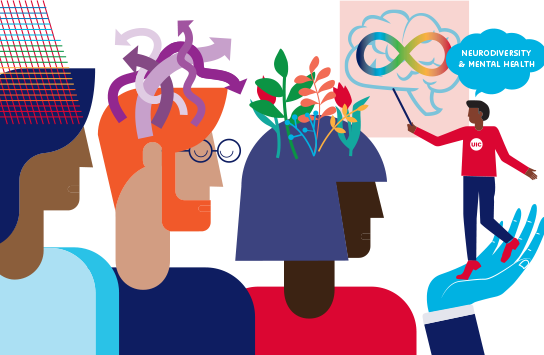Autism Acceptance Month: Neurodiversity, Mental Health and Wellness Going Into Finals
ED TECH SPOTLIGHT
quote
Just as the prevailing culture entrains and pushes people into the embodied performance of heteronormative gender roles, it also entrains and pushes us into the embodied performance of neurotypicality—the performance of what the dominant culture considers a ‘‘normal’’ bodymind.
text

April is Autism Acceptance Month, and with it comes an opportunity to learn about the different ways our brains work to process information. Neurodiversity understands autism as a natural variation in the way that our brains are wired. This framing encourages an understanding of autism from a growth mindset, rather than from a deficit one where neurotypicality is “normal” and all else is a deviation.[1] The deficit mindset of autism is a key characteristic of the pathology paradigm, a phrase coined by Dr. Nick Walker, a neurodiversity advocate, psychologist, and scholar at the California Institute of Integral Studies. Instead, Dr. Walker urges us to adopt a neurodiversity paradigm and to become “neuroqueer.” She explains
Just as the prevailing culture entrains and pushes people into the embodied performance of heteronormative gender roles, it also entrains and pushes us into the embodied performance of neurotypicality—the performance of what the dominant culture considers a ‘‘normal’’ bodymind. And just as heteronormativity can be queered, so can neurotypicality: we can subvert, disrupt, and deviate from the embodied performance of being neurocognitively ‘‘normal.’’ That’s neuroqueering (or being neuroqueer).[2]
In this context, the brain functions of autistic persons can be viewed positively with benefits for self and society.[3]
Neurodiversity as a movement seeks to acknowledge and protect the civil rights of those whose brain wiring differs from the neurotypical. It is a call to action, and creates an obligation for the neurotypical, from their position of privilege, to advocate for inclusive learning and classroom practices for the neurodiverse. The neurodiversity movement is also a call to listen to the experiences of the neurodiverse, and make space for the heart and head knowledge that they impart. Autism is not a disorder, but “a human specificity or difference, with different ways of socializing, communicating and sensing” that require our respect.[4]
Whether neurodiverse or neurotypical, all of us face the mental stress of the looming final exam season. May is Mental Health Awareness Month, and Mental Health America’s 2023 Mental Health Month Campaign theme is “look around, look within.” The campaign connects environment with mental health, and asks us to consider how housing, home life, community, and nature can cultivate our well-being. MHA has created a toolkit that contains activities, articles, and curated social media images that you can use in e-mails and Zoom to promote mental health awareness in your communications with students. The National Alliance on Mental Illness (NAMI) amplifies the message “More Than Enough” for its Mental Health Awareness Month campaign. NAMI’s guide features online and in-person activities to raise awareness through connection, education, and advocacy. NAMI also offers this short, informative blog post for students 7 Tips for Coping With the Stress of Finals. As we finish out the semester strong, remember that you are more than enough to meet the challenge of finals, and an able advocate for a neuroinclusive future.
[1] See generally Dana Lee Baker, Neurodiversity, Neurological Disability, and the Public Sector: Notes on the Autism Spectrum, 21:1 Disability and Society, 15–29 (2006); Alicia A. Broderick & Ari Ne’eman, Autism As Metaphor: Narrative and Counter-narrative,12:5 International Journal of Inclusive Education, 459–476 (2008); Andrew Fenton & Tim Krahn, Autism, Neurodiversity and Equality Beyond the ‘Normal’, 2:2 Journal of Ethics in Mental Health, 1–6 (2007).
[2] Nick Walker & Dora M. Raymaker, Toward a Neuroqueer Future: An Interview with Nick Walker, 3:1 Autism in Adulthood 5, 9 (2021).
[3] Piers Jaarsma & Stellan Welin, Autism as a Natural Human Variation: Reflections on the Claims of the Neurodiversity Movement, 20 Health Care Anal 20, 22-23 (2012).
[4] Jaarsma & Welin, 23.